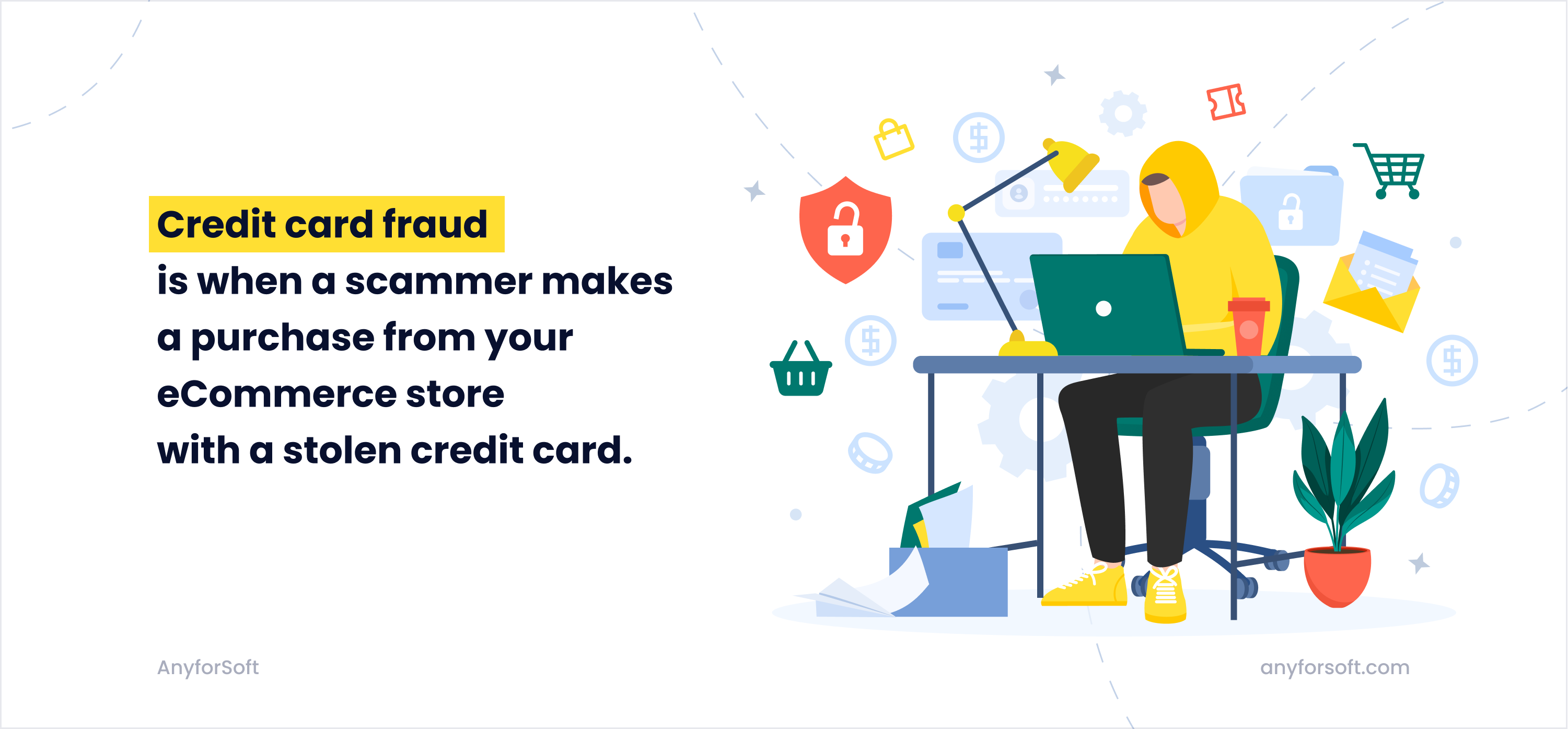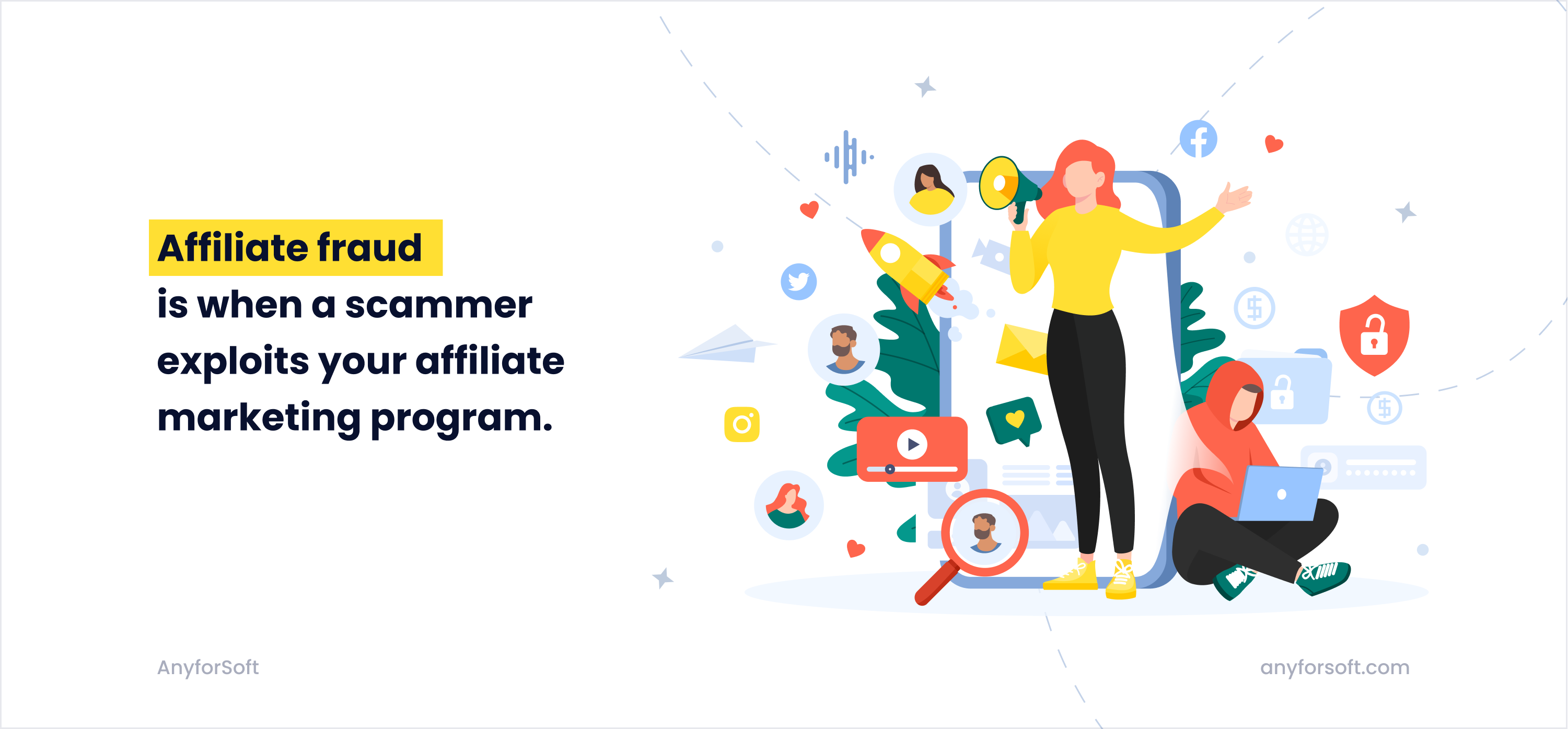Being a merchant is risky. Online stores are constantly subject to various eCommerce security threats that wreak havoc on the finances of their owners. According to Statista, the eCommerce industry lost twenty billion dollars to online payment fraud in 2021 alone.
Just think about it: twenty BILLION dollars to only ONE type of fraudulent activity in ONE year.
But apart from online payment fraud, there are many more schemes invented by resourceful scammers. It’s scary to even think how much financial loss they collectively cause to the industry. In any case, some of these schemes are so damaging that if you fail to protect your eCommerce site against them, they might eventually put you out of business.
The question is, how can you shield your online store from potential damage?
That’s exactly what we are going to discuss.
As a company that offers quality eCommerce development services, AnyforSoft has vast experience in developing security products that protect eCommerce businesses from most cyber threats. In this blog post, we share some insights into the most common eCommerce security threats. More specifically, we describe popular methods frauds use to capitalize on unprotected websites and steal money from the wallets of their owners. We also explain how to protect against these threats so that they don’t harm your eCommerce store.
Forewarned is forearmed, as the saying goes.
So without further ado, let’s dive deep into discussing the most common threats and eCommerce security best practices.
#1 Credit card fraud

We already described how to build an eCommerce website from scratch. Now it’s time to protect it. And the first on our list of the most common security threats in eCommerce is credit card fraud.
What it is: Credit card fraud is a type of financial fraud in which a scammer makes a purchase from your eCommerce store with a stolen credit card. As a result, when it comes to the attention of the real cardholder, they request chargebacks on the grounds that they didn’t make any purchases.
These requests are often approved by banks, so all the money that you earned is going back to the card owner. The problem is, your goods are already in the scammer’s hands, and the odds are you will never see them again.
How to protect against credit card frauds
Needless to say, this type of financial fraud causes significant damage to eCommerce store owners. Luckily, there are ways to address the issue:
- Usually, when a buyer uses stolen credit card data, the billing address they submit differs from the actual billing address on record at the issuing bank. Thus, you can dramatically minimize card fraud by installing an address verification system (AVS).
- Another red flag is accounts that try to make purchases with too many different bank cards. When one account attempts to order goods with different cards, they’re likely card testing—checking which of their stolen credit cards work. We suggest banning such accounts to prevent such a security risk of eCommerce.
- Also, look out for foreign IP locations. For instance, if your store serves customers in the US only, but someone is attempting to make a purchase from India, that should be a warning sign.
- Last but not least, stay vigilant when someone places a high-volume order. Scammers that have access to someone else’s credit card information tend to purchase high-ticket items since the money they’re spending isn’t their own.
To significantly minimize credit card fraud, we suggest investing in a fraud protection system. AnyforSoft has extensive experience in developing them.
For example, we created a sophisticated fraud protection system for an online beauty store Bellame. This system automatically identifies suspicious activities, checks the billing information, and conducts additional security checks. When it suspects a certain user might be distrustful, it calculates the probability of fraud and informs account managers about a potential threat. That helps Bellame prevent such eCommerce threats as payment fraud and save thousands of dollars every month.
#2 Intentional friendly fraud
Another popular threat to eCommerce sites is intentional friendly fraud (also known as chargeback fraud and a fake return request).
What it is: Intentional friendly fraud is when someone makes a purchase with the intent to later dispute the charge with their bank and thus get the ordered item for free. This type of fraud has become so popular lately that you can find hundreds of videos on YouTube explaining how to get goods from popular stores free of charge by abusing this method.
So what scammers do is purchase an item, then contact their bank to dispute a charge. They say that the purchase was unauthorized, the product came damaged, or make any other claim to justify the chargeback. They also lie that they are unable to contact the merchant or that the merchant refused to issue a refund. Unfortunately, banks often take the customer’s side without thoroughly investigating the matter, so such chargebacks get approved.
How to protect against intentional friendly fraud
There is no guaranteed way to protect against such security threats to eCommerce as intentional friendly fraud. However, it’s still worth taking action:
- Document each order you receive. That way, if a bank contacts you, you will be able to submit relevant documentation as evidence that a customer indeed made a purchase.
- Maintain a blacklist of customers who regularly file chargebacks. If you notice that a certain individual has a tendency to request chargebacks for their purchases, the best way to deal with them is to ban them from ordering from your store.
- Implement machine learning algorithms. Machine learning algorithms can automatically determine which customers are more likely to dispute purchases or request refunds based on their past behavior.
#3 Affiliate fraud

Affiliate fraud is third on our list of security threats for eCommerce sites.
What it is: Basically, affiliate fraud is when a scammer exploits your affiliate marketing program. There are multiple methods swindlers might use to take advantage of your system: it will depend on what type of affiliate marketing programs your eCommerce store offers.
Here are some examples of how inventive frauds might exploit them:
Cookie stuffing
Using malicious software, scammers place special cookies on your customers’ computers. It grants them a commission for any future purchases that are made from the computers with these cookies.
Bot traffic
Using bots is popular when it comes to traffic-based affiliate programs. If you pay affiliates for the number of people they attract to your store, be prepared that some will abuse this system by sending bots instead of real users.
Clicking software
Clicking software is used to exploit pay-per-click affiliate programs. In such programs, an affiliate marketer publishes an advertiser’s ad on their site to help the latter increase traffic. In response, the advertiser pays a fee to the affiliate each time the ad is clicked.
What unscrupulous affiliates do is use clicking software to repeatedly click on the advertising and thus generate commissions.
How to protect against affiliate fraud
To protect against threats to eCommerce systems related to affiliate marketing, consider the following:
- Set up a bot trap. A bot trap is a link in your website’s HTML code that is invisible to real users but can be accessed by bots. The idea behind this is that you place a link on your page that directs to a bot trap directory (/bot-trap/index.php). Then you create a robots.txt file telling bad bots not to visit that directory. When they do it anyway, your site adds their IP addresses to a block list. After that, bots can’t access your site, and affiliates that send bot traffic to your store won’t get a dime from you.
- Enable device fingerprinting. Each visitor that lands on your site has a digital footprint: the configuration of the software and hardware they use. With a device fingerprinting module on your eCommerce site, you will be able to assign IDs to these configurations and then track suspicious activity. For example, if you see the same configuration in different accounts, that might be a fraudster abusing your affiliate program by creating multiple accounts. Knowing this, you can ban the scammer and prevent potential damage.
- Vet your affiliate partners. Another method to minimize affiliate fraud threats to eCommerce is to thoroughly vet affiliate partners. Ask an affiliate to provide you with examples of their monetization projects and current campaigns. Also, inquire as to how and where they plan to run your ad campaign.
#4 Cross-site scripting
Cross-site scripting (or XSS) is one of the most dangerous and harmful eCommerce security threats.
What it is: In simple terms, cross-site scripting is a type of cyber attack in which a threat actor uses a website’s vulnerability to inject malicious code (in most cases, JavaScript). This code then runs in the browser of an unsuspecting user, causing harm. Since eCommerce sites store sensitive data (such as customers’ credit card details and other personal information), they are frequently targeted by hackers performing XSS attacks.
When conducting hacker attacks with malicious scripts, cybercriminals usually attempt to steal authentication data: logins, passwords, session tokens. Having obtained it, they can log in to your eCommerce store as a customer with the purpose of malicious activity: for example, they might change the shipping address for a recurring order or use the customer’s card data to purchase goods.
But it is much worse when hackers steal the credentials of your administrators. In such cases, they can visit your admin panel with the sensitive information of all your customers and send this info to their servers. Just imagine how much harm they can later cause with credit card details as well as the logins, passwords, and personal information of each customer. Therefore, if your eCommerce site has such a security breach as an XSS vulnerability, you should address it immediately.
How to protect against cross-site scripting
Most content management systems are protected against cross-site scripting by default. However, hackers often find security vulnerabilities in third-party plugins. To ensure that your eCommerce platform is not exposed to security issues in eCommerce such as XSS cyber attacks, follow these practices:
- Get rid of questionable third-party plugins. Also, timely update the plugins that you want to keep to ensure cyber security.
- Validate and sanitize the input. eCommerce stores are vulnerable to XSS attacks when they don’t filter the user input. For example, if the comment section on your website enables users to add HTML, an attacker can post a comment with malicious code. Considering this, you should validate all the user data and sanitize it: i.e., remove unwanted data, such as unsafe HTML tags.
- Use Content Security Policy. Content Security Policy (CSP) is a W3C standard that can help you prevent Cross-Site Scripting (XSS) as well as other attacks associated with malicious code injections.
- Ensure that your shopping cart software is updated. Hackers often type malicious scripts into shopping carts. Thus, you need to make sure that the shopping cart software you use is up-to-date with all the security patches installed.
Other threats to be aware of
Apart from the main threats described above, you should also be on the lookout for:
Phishing attacks
A phishing attack is a cyber attack in which an attacker, pretending to be a trustworthy entity, tries to deceive your eCommerce platform workers or yourself into sharing sensitive information: passwords, credit card information, or personal data. They typically send fraudulent emails, messages, or create fake websites that mimic existing organizations—banks, social media platforms, or online retailers.
The goal of such an attack is to trick the recipient into providing their confidential information or clicking on malicious links. If they succeed, this may lead to identity theft, financial loss, unauthorized transactions, or unauthorized access to accounts. Phishing attacks exploit psychological tactics, urgency, or fear to manipulate victims into taking actions that benefit the attacker. To protect your business against this threat, it is crucial to stay vigilant, verify the authenticity of requests or messages you receive, avoid clicking on suspicious links, and use website security measures such as two-factor authentication. Also, you should inform your workers about the danger of phishing attacks and other security threats so that they won't put your eCommerce platform in danger.
Spamming
Spamming is when someone sends unsolicited and unwanted messages, typically in bulk, to a large number of online retailers. These messages are usually sent via email, but when it comes to eCommerce platforms, they often occur in the comments sections. Given that spam messages usually contain infected links with malicious content, you should definitely protect your store against them, ensuring your website's security. Luckily, you don't need expensive anti-malware software to do that. Simply install a filter that would delete comments with links—in most cases, it should be enough.
DDoS attacks
Distributed denial of service attacks or simply DDoS attacks are hacker attacks during which bad actors use malicious programs to send an overwhelming amount of requests from various IP addresses (usually untraceable) to your servers, causing them to crash. Thus, your e-commerce store becomes unavailable to buyers, which prevents you from selling your goods, resulting in significant financial losses. Oftentimes, these attacks are carried out by your competitors—by making your store down, they secure more sales for themselves.
To protect your store from DDoS attacks, you should ensure multi-layer security. One of the ways is to use rate limiting and filtering. By implementing these mechanisms, you can restrict the number of requests from a single IP address or simply block suspicious IP addresses from making any requests. Also, consider configuring your network infrastructure in such a way as to handle high volumes of traffic effectively. Implement load balancers, firewalls, and intrusion detection systems (IDS) to identify and mitigate DDoS attacks. In addition to that, don't forget to timely update your CMS to receive the latest security updates.
Common methods for minimizing ecommerce security threats
Of course, there are many more potential threats to eCommerce stores. Above, we described only the ones that are the most relevant to the industry. However, besides them, one can come across “universal” cyber fraud activities capable of wreaking havoc on any digital industry. They include DDOS attacks, phishing attempts, sending spam, SQL injections, brute force attacks, and so on.
While there is no one-stop data protection solution that could shield you from all the mentioned threats of eCommerce, you can still implement these best practices to minimize the risks:
- Install SSL certificate. SSL encrypts sensitive data that goes between a user’s browser and your server, preventing scammers from accessing it.
- Enable two-factor authentication. Even if a scammer gets the credentials of your administrators, they won’t be able to gain access to the site if you enable two-factor authentication.
- Educate your staff. Anyone working for your eCommerce store should know about phishing, brute force attacks, spamming, and other security concerns. Tell your team to not click on questionable links, also show them how to create strong passwords and deal with social engineering.
- Use secure payment gateways. It’s better not to store your customers’ credit card data on your servers. Instead, use a third-party service, such as Paypal or Stripe, to handle payment transactions on their side. That way, even if your site gets hacked, you can rest assured that the sensitive data of your clients is secure.
- Back up your website. Having backup copies of your eCommerce website will enable you to restore it in case a hacker deletes your content and data.
- Secure the admin panel. Come up with complex passwords for your website administrators to minimize brute force threats in eCommerce.

Ecommerce security threats and solutions: let professionals protect your data
There is no fire-sure way to prevent all eCommerce cyber attacks and other threats. However, modern solutions enable us to significantly minimize the risks associated with cybercriminal activities. The problem is, to protect against DDOS attacks, cross-site scripting, SQL injections, and other hacker attacks, you need to be tech-savvy and have web development skills. Otherwise, you won’t be able to implement the data security measures required to make your online store safe.
But don’t worry—you can always count on us. At AnyforSoft, we care about our customers and help them make their eCommerce stores secure. If you want to protect your website from hackers and scammers but don’t have enough experience working with data security solutions, you can outsource this to us. We will build a professional development team with relevant expertise to help you ensure your store’s protection.
Let professionals handle the security side and focus on conversions instead. Just contact us and tell us about your project—we will reply shortly.
